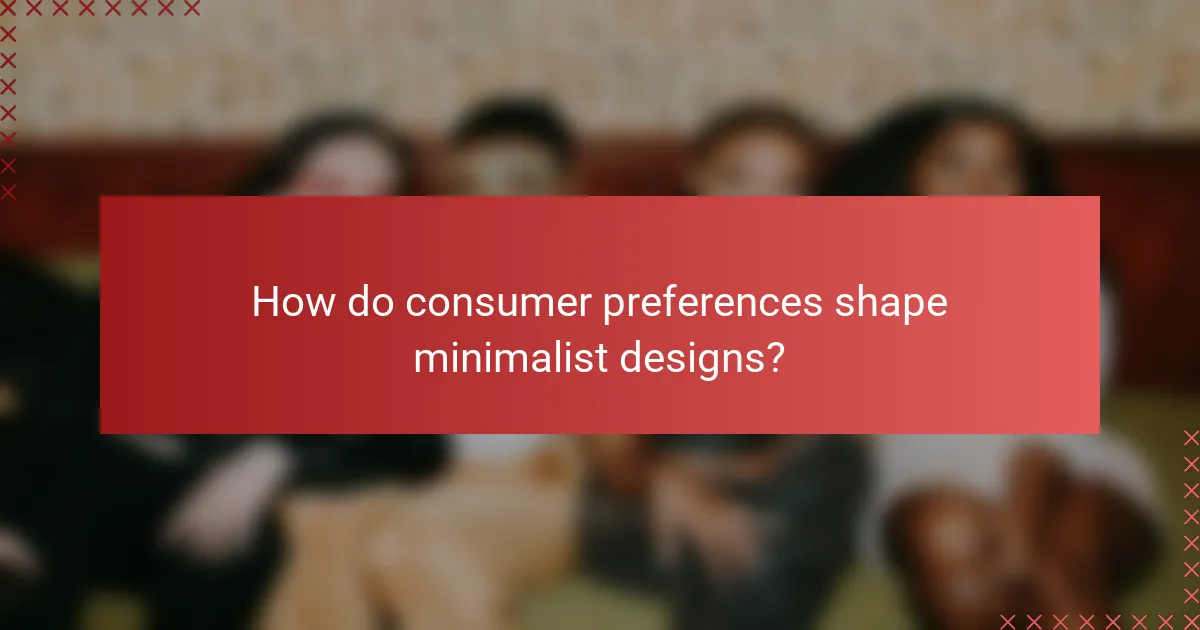Minimalist designs have gained significant popularity as consumers increasingly favor simplicity, functionality, and sustainability in their choices. This trend reflects a desire for practical aesthetics that enhance everyday living while promoting eco-friendly practices. As a result, products that embody clean lines and neutral colors are becoming essential in creating uncluttered and versatile spaces.

What are the current trends in minimalist design in the US?
Current trends in minimalist design in the US emphasize simplicity, functionality, and sustainability. Consumers are increasingly drawn to designs that not only look clean but also serve multiple purposes while promoting eco-friendly practices.
Increased focus on sustainability
Sustainability is a key trend in minimalist design, with consumers prioritizing eco-friendly materials and practices. Furniture made from reclaimed wood, recycled metals, and organic fabrics are gaining popularity as they align with the minimalist ethos of reducing waste.
Brands are responding by offering products that are not only stylish but also environmentally responsible. Look for certifications like FSC (Forest Stewardship Council) to ensure sustainable sourcing.
Preference for multifunctional furniture
Multifunctional furniture is a hallmark of minimalist design, catering to the need for efficient use of space. Items such as sofa beds, extendable dining tables, and storage ottomans allow for flexibility in smaller living areas.
When selecting multifunctional pieces, consider your lifestyle and the specific functions you need. This approach helps maximize utility without compromising on aesthetics.
Rise of neutral color palettes
Neutral color palettes are increasingly favored in minimalist design, creating a serene and cohesive environment. Shades like whites, grays, and beiges provide a versatile backdrop that enhances the simplicity of the space.
To add interest, consider incorporating textures and subtle patterns within these neutral tones. This keeps the design visually appealing while maintaining a minimalist approach.
Integration of technology
Technology integration is becoming essential in minimalist design, with smart home devices seamlessly blending into the aesthetic. Features like hidden speakers, smart lighting, and automated window treatments enhance convenience without cluttering the space.
When choosing technology, opt for sleek, unobtrusive designs that complement your minimalist vision. This ensures that functionality does not detract from the overall simplicity.
Emphasis on open spaces
Open spaces are a fundamental aspect of minimalist design, promoting a sense of freedom and tranquility. Removing unnecessary walls and barriers allows for better flow and natural light, making spaces feel larger and more inviting.
To achieve this, consider using room dividers that are lightweight and transparent, such as glass or fabric screens. This maintains the openness while providing subtle separation when needed.

How do consumer preferences shape minimalist designs?
Consumer preferences significantly influence minimalist designs by prioritizing simplicity, functionality, and sustainability. As individuals seek to create uncluttered spaces, their choices reflect a desire for practical aesthetics that enhance their daily lives.
Demand for simplicity and functionality
The demand for simplicity in design stems from a desire for less clutter and more efficient use of space. Consumers increasingly prefer products that serve multiple purposes, such as furniture that can be easily transformed or stored away. This trend encourages manufacturers to focus on clean lines and intuitive designs that enhance usability.
For example, modular furniture systems that can be reconfigured to fit various room layouts are gaining popularity. This flexibility allows consumers to adapt their living spaces without the need for extensive renovations.
Interest in eco-friendly materials
As awareness of environmental issues grows, consumers are gravitating towards minimalist designs that utilize eco-friendly materials. Sustainable options like bamboo, reclaimed wood, and recycled metals not only reduce environmental impact but also align with the minimalist ethos of simplicity and authenticity.
Choosing products made from natural materials can enhance the aesthetic appeal of a space while promoting a healthier indoor environment. Brands that highlight their commitment to sustainability often attract a loyal customer base willing to invest in higher-quality, eco-conscious items.
Influence of social media on aesthetics
Social media platforms play a crucial role in shaping consumer preferences for minimalist designs by showcasing visually appealing, curated spaces. Influencers and design enthusiasts share images of minimalist interiors that emphasize clean aesthetics, which inspires followers to adopt similar styles in their own homes.
Platforms like Instagram and Pinterest serve as valuable resources for discovering new trends and ideas. As consumers engage with these platforms, they often seek out products and designs that reflect the minimalist ideals they admire online.
Desire for personalized spaces
While minimalism emphasizes simplicity, consumers are increasingly looking to personalize their spaces within this framework. This desire for individuality leads to the incorporation of unique decor elements that reflect personal style, such as art pieces or handcrafted items.
Balancing minimalism with personalization can be achieved by selecting a few statement pieces that stand out against a neutral backdrop. This approach allows for self-expression while maintaining the clean, uncluttered look that minimalist designs promote.

What are the best minimalist design products available online?
The best minimalist design products available online focus on simplicity, functionality, and aesthetic appeal. These items often emphasize clean lines and neutral colors, making them versatile for various home and lifestyle needs.
Muji home essentials
Muji offers a range of home essentials that embody minimalist design principles. Their products, such as storage solutions, kitchenware, and bedding, prioritize functionality without unnecessary embellishments.
When selecting Muji items, consider their commitment to sustainability and simplicity. Many products are made from eco-friendly materials, and their clean aesthetic can seamlessly fit into any modern home.
IKEA minimalist furniture
IKEA is renowned for its minimalist furniture that combines style with affordability. Their pieces often feature modular designs, allowing for customizable arrangements that suit various spaces.
Look for items like the KALLAX shelving unit or the MALM bed frame, which exemplify minimalist principles. These products are designed for easy assembly and can be adapted to different room layouts, making them practical choices for small or large spaces alike.
West Elm decor items
West Elm provides decor items that enhance minimalist aesthetics while adding a touch of elegance. Their collection includes everything from wall art to lighting fixtures, all designed with clean lines and subtle colors.
When choosing West Elm decor, focus on pieces that complement your existing furniture. Items like geometric vases or simple pendant lights can elevate a room without overwhelming it, maintaining a serene atmosphere.
Fjällräven bags and accessories
Fjällräven specializes in minimalist bags and accessories that are both functional and stylish. Their products, such as the Kånken backpack, are designed for durability and practicality, making them ideal for everyday use.
Consider the versatility of Fjällräven items; they often come in various colors and sizes, allowing you to choose one that fits your personal style while adhering to minimalist principles. Their focus on sustainability also adds to their appeal, as many products are made from recycled materials.

How does minimalist design impact consumer purchasing decisions?
Minimalist design significantly influences consumer purchasing decisions by enhancing the perceived value of products and simplifying the decision-making process. Shoppers are often drawn to clean, uncluttered aesthetics that convey quality and clarity, leading to increased trust and willingness to buy.
Higher perceived value of quality items
Minimalist design elevates the perceived value of products by emphasizing their quality and craftsmanship. When items are presented with a simple, elegant design, consumers often associate them with higher standards and exclusivity. For example, brands like Apple and Muji utilize minimalism to create a sense of premium quality, which can justify higher price points.
To leverage this effect, businesses should focus on high-quality materials and craftsmanship while maintaining a clean aesthetic. This approach can enhance consumer perceptions and justify a premium pricing strategy.
Preference for brands with clear messaging
Consumers gravitate towards brands that communicate their values and offerings clearly, which is a hallmark of minimalist design. A straightforward design eliminates distractions, allowing the core message to shine through. Brands like Everlane and IKEA exemplify this by using simple visuals and concise messaging to convey their commitment to transparency and sustainability.
To attract consumers, brands should prioritize clarity in their marketing materials and product presentations. Avoid jargon and complex visuals; instead, focus on straightforward language and clean layouts that resonate with minimalist principles.
Influence of lifestyle branding
Minimalist design aligns well with lifestyle branding, which emphasizes a particular way of living that resonates with consumers. Brands that adopt minimalist aesthetics often promote values like simplicity, sustainability, and mindfulness, appealing to consumers seeking a more intentional lifestyle. For instance, brands like Patagonia and Toms use minimalist design to reflect their commitment to environmental and social responsibility.
To effectively utilize lifestyle branding, companies should ensure that their design choices reflect their core values and resonate with their target audience. This alignment can foster a deeper emotional connection with consumers, driving loyalty and repeat purchases.

What are the key factors influencing minimalist design choices?
Key factors influencing minimalist design choices include space availability, budget constraints, and personal style. These elements shape how consumers approach minimalist aesthetics, impacting their decisions in both residential and commercial settings.
Space availability and layout
Space availability is crucial in determining minimalist design. In smaller areas, minimalism helps create an illusion of openness, making spaces feel larger and more inviting. For instance, using multifunctional furniture can maximize utility while maintaining a clean aesthetic.
When planning a layout, consider how each piece of furniture contributes to the overall flow. Open floor plans often benefit from minimalist designs, as they reduce visual clutter and enhance the sense of space.
Budget constraints
Budget constraints significantly affect minimalist design choices. Consumers often prioritize quality over quantity, opting for fewer, high-quality items instead of many lower-cost alternatives. This approach can lead to a more cohesive and stylish environment.
When working with a limited budget, focus on essential pieces that serve multiple functions. For example, a well-designed sofa bed can provide seating and sleeping options without overcrowding the space.
Personal style and identity
Personal style and identity play a vital role in minimalist design preferences. Many individuals gravitate towards minimalism as a reflection of their values, such as simplicity and sustainability. This trend often leads to a curated selection of items that resonate with their lifestyle.
To align minimalist design with personal identity, consider incorporating meaningful decor items that tell a story or evoke memories. This balance between minimalism and personal expression can create a unique and inviting atmosphere.
